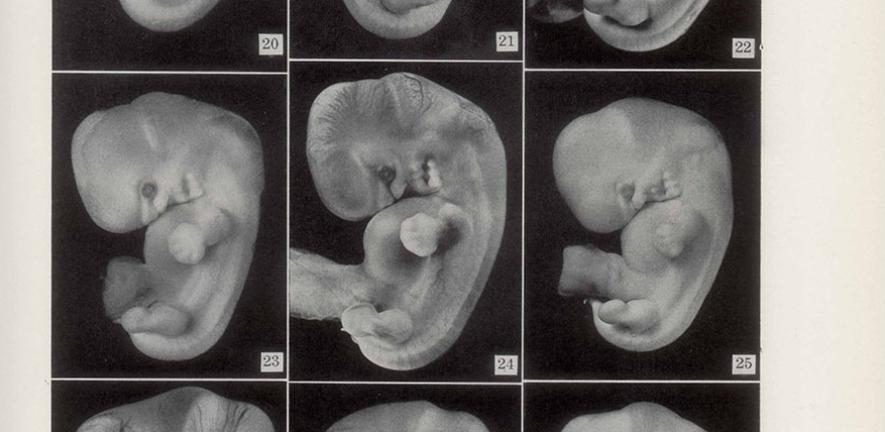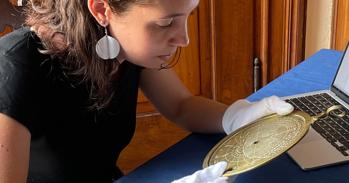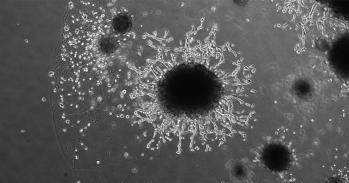
A new study takes a tour of the history of research into human embryology and development to show the "cycles of attention" that led to major scientific breakthroughs.
A new study takes a tour of the history of research into human embryology and development to show the "cycles of attention" that led to major scientific breakthroughs.
Analysing the past sheds light on the present resurgence of research on human development. That’s the lesson of a new study by Professor Nick Hopwood, from the Department of History and Philosophy of Science, that is published in the Journal of the History of Biology. The paper discusses the flourishing of human embryology a century ago, its drop in popularity after World War II, and especially its revival since the late twentieth century.
“Every journal article and news story about human development includes a bit of history, but it’s often narrow, rarely informative and not always accurate”, Hopwood says. “I wanted to stand back and see a bigger picture, then dig down to find out how and why there has been such a surge of attention. Working in Cambridge made that easier.”
The University has been at the forefront of innovation, from the first test-tube baby to the extended culture of early embryos, organoids and other stem-cell models. The networking through Cambridge Reproduction of expertise in science and medicine, humanities and social sciences helped Hopwood reconstruct the genesis of these advances. This took a combination of research in libraries and archives and interactions with scientists, including interviews, sharing of documents, attending conferences and giving talks, here and elsewhere.
“Human development has long been of special interest as evidence of our origins and for its medical relevance, but is hard to study”, Hopwood explains. “Historically there have been two main approaches. Either deciding that it’s too difficult to research human embryos because they’re usually hidden in pregnant bodies, so we should study other animals and hope results will transfer. That’s an indirect approach. Or trying for the best possible results from the few human specimens that can be obtained. That’s a direct approach. My article analyses the rise of research directly on human material as part of the changing politics of choosing a species to study. I explore how researchers distanced themselves from work on animal models but even human studies depended on this.”
Interest in human embryos grew in the later 19th century, following debates about evolution. Darwinists pointed to the similarity of humans and other animals at early stages as evidence of common descent. Critical anatomists responded by setting up networks of physicians to collect material, mainly from women’s pregnancy losses. New techniques such as serial sectioning and wax modelling from the slices made details of internal structure visible in 3-D.
This led to a watershed moment: the establishment by the Carnegie Institution of Washington of a Department of Embryology at Johns Hopkins University in Baltimore. Founded in 1914, the first research institution devoted specifically to embryology focused on human embryos, now also increasingly recovered from aseptic operations for various conditions. Important discoveries include elucidation of the timing of ovulation in the menstrual cycle, initially in rhesus macaques. Human embryos from the first two weeks after fertilization were described for the first time.
Flies, frogs and chicks
After World War II human embryology ran out of steam. A new field, developmental biology, focused on model organisms, such as flies, frogs, chicks and, as the exemplary mammal, mice.
“To make progress, the argument went, it was necessary to work on species where more could be done more easily”, Hopwood explains. “That meant micromanipulation, enough material to do biochemistry and molecular biology, and genetic tools.” This approach demonstrated its power in the 1980s, when mechanisms of development were found to be more conserved across the animal kingdom than researchers had imagined. Yet from around the same time interest revived in using human material.
“There was not a steadily rising curve of research on human development through the twentieth century”, Hopwood contends. “Instead, human embryos have gone through cycles of attention and neglect. As opportunities opened up and the balance of power shifted between researchers invested in different organisms, so the politics of species choice have changed. Over the last four decades we’ve seen a renewal of research directly on human development. This is in the first place because of changes in supply and demand.”
The achievement of human in-vitro fertilisation, with a live birth in 1978, gave access to embryos before implantation in the uterus. After much debate the UK Human Fertilisation and Embryology Act 1990 permitted donated embryos to be kept in vitro, under strict regulations, for up to 14 days from fertilization. Though only in 2016 was that limit approached. Meanwhile, biobanks, notably the Human Developmental Biology Resource in Newcastle and London, provided ethical supplies of post-implantation stages from terminations of pregnancy.
There has been opposition from anti-abortion activists, and many fewer embryos are donated for research than scientists (and some patients) would like. But the field was transformed. As in the years around 1900, new technologies eased the study of human embryos. Only now the advances were in digital communication, molecular analysis and imaging methods. Optical slices and computer graphics replaced microscope slides and wax models.
Beyond mice
To obtain human embryos with permission and funding to study them, researchers had to make the case for studying our own species. They stimulated demand by arguing that it would no longer do simply to extrapolate from mice. Knowledge and skills from the mouse model could be applied, but the differences as well as the similarities had to be explored. That was crucial before clinical application, as in fertility treatments. It was also desirable in discovering what makes us human—or at least not mice. Funders were keen to support medically relevant research or “translational science”.
In the last fifteen years another kind of model has transformed the politics of species choice. Subject to ongoing ethical negotiations, stem-cell-based embryo models have enabled fresh kinds of experiment on human development. Some researchers even argue that, for investigating fundamentals of vertebrate development, these human systems are now the model. Mice remain a crucial resource, with almost every innovation made on them first. But since their development is rather peculiar, other laboratories are promoting comparisons with species that develop more like humans.
Around ten years ago, all this inspired the organization of a new sub-field, human developmental biology, not least through a series of conferences. Major research programmes, such as the Human Developmental Biology Initiative, bring together scientists working, in different ways, on various aspects of embryogenesis.
Questions remain. Hopwood’s historical research concentrated on the USA and the UK, with nods to continental Europe and Japan. It would be good to explore other countries’ histories, he suggests, especially since differences in reproductive politics and infrastructure mean that access to material is uneven.
More generally, Hopwood argues, “history can contribute by showing how we got here and clarifying the arguments that have been used”. “It helps stakeholders see why there are now such opportunities for research on human development, and that, because arrangements are fragile, it will take work to gain and keep public support.” So a long-term perspective can assist researchers and funders in thinking about what might happen next.
“Interest in human development has risen and fallen and risen again. Are we now going through another cycle of attention, or could interest be maintained? Will the balance shift back to animal models or will we see an ever greater focus on humans, at least in the form of stem-cell models? How might present actions shape choice of species in the future?”
The research was part-funded by a Major Research Fellowship from the Leverhulme Trust. Story by Edward Grierson from the School of Humanities and Social Sciences communications team.

The text in this work is licensed under a Creative Commons Attribution-NonCommercial-ShareAlike 4.0 International License. Images, including our videos, are Copyright ©University of Cambridge and licensors/contributors as identified. All rights reserved. We make our image and video content available in a number of ways – on our main website under its Terms and conditions, and on a range of channels including social media that permit your use and sharing of our content under their respective Terms.




